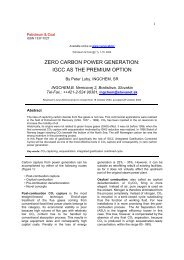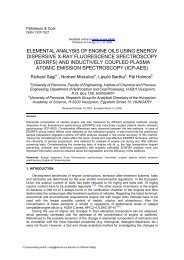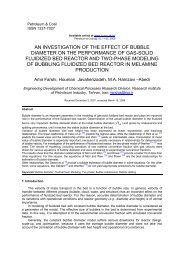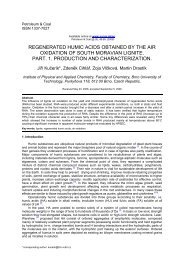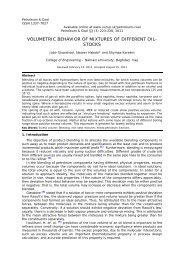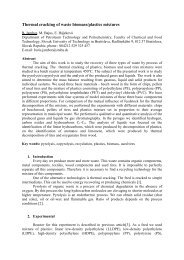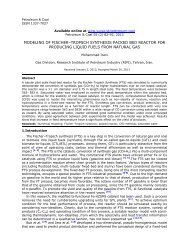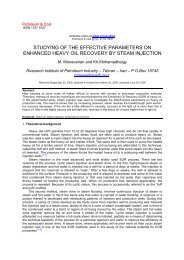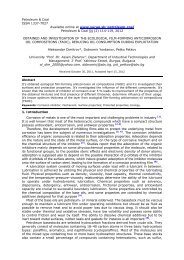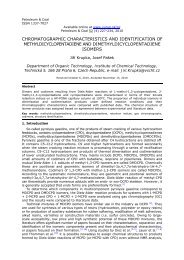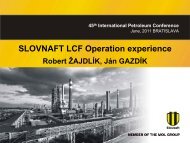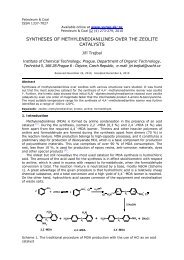CountsD:\Analytical\...\Me-Bs-6_111222170734 22.12.2011 г. 17:07:34Fatty acid content, %D. I. Yordanov, Z. B. Tsonev, T. V. Palichev, Z. A. Mustafa/Petroleum & Coal 55(2) 74-81, 2013 79RT: 0.20 - 38.001000000009500000090000000NL:1.34E8FIDAnalogMe-Bs-6_1112221707345045450 W 300 W Dried at 20°C 120-150°C 600W850000008000000040750000007000000015.3735650000006000000019.53305500000050000000450000004000000025203500000030000000250000002000000018.8218.481510150000001000000022.125500000001.335.6710.2522.56 27.1812.12 16.0830.61 34.925 10 15 20 25 30 35Time (min)Fig. 6. GC chromatogram <strong>of</strong> <strong>the</strong> lipid extractfrom c<strong>of</strong>fee residue irradiated by 600Wmicrowave <strong>for</strong> 20 minutes0Fattyacid14:0 16:0 18:0 9-18:1 11-18:1 18:2 18:3 20:0 20:1 21:0 22:0 23:0 24:0Fig. 7. Fatty acid content based on <strong>the</strong> resultsfrom Table 3.From our study and <strong>the</strong> data shown in Figure 7, we observe that any type <strong>of</strong> pretreatment(microwave irradiation or heat treatment only) <strong>of</strong> c<strong>of</strong>fee residue from vending automatincreases <strong>the</strong> amount <strong>of</strong> saturated fatty acids.The palmitic and linoleic acids have <strong>the</strong> highest percentage in <strong>the</strong> analyzed extracts.The amount <strong>of</strong> stearic, oleic and arachidic acids are significant. The percentage <strong>of</strong> all o<strong>the</strong>rfatty acids is less than one.If <strong>the</strong> c<strong>of</strong>fee residue is not processed in any way, <strong>the</strong> greatest is <strong>the</strong> amount <strong>of</strong> unsaturatedfatty acids with more than one double bond. The residue treated at 120-150 C have asignificant content <strong>of</strong> saturated fatty acids and those containing one double bond, and<strong>the</strong>re<strong>for</strong>e <strong>the</strong> least amount <strong>of</strong> fatty acids with two or more double bonds.The c<strong>of</strong>fee residue that was treated at 600W microwave has <strong>the</strong> fatty acid compositionsimilar to those <strong>of</strong> residue processed at 120-150 C. The residue processed at 450W microwaveirradiation has <strong>the</strong> fatty acid composition similar to those <strong>of</strong> residue dried at 20 C. Thesample treated at 300W microwave irradiation has a similar composition as those processedat 450W microwave irradiation.The triacylglycerols have <strong>the</strong> higher content in <strong>the</strong> neutral lipids (over 45%). This rateis <strong>the</strong> lowest in <strong>the</strong> sample that was treated at 120-150 C (46.8%). The residue dried at20 C has <strong>the</strong> highest percentage <strong>of</strong> triacylglycerols (67.1%). The residues dried at 120-150 C and irradiated at 600W microwave have <strong>the</strong> higher percent <strong>of</strong> sterols, diacylglycerols,and free fatty acids in sum.The percentage <strong>of</strong> lipids is calculated from <strong>the</strong> original sample by <strong>the</strong> extraction thatwas made. In our case, when we were added <strong>the</strong> amounts <strong>of</strong> lipid classes and adjustment tolipid extract were obtained <strong>the</strong> percentages <strong>of</strong> dyes, etc. accompanying substances thatdiffer in polarity <strong>of</strong> <strong>the</strong> lipid classes. Based on <strong>the</strong> data from Figure 9 and Tables 5 and 6,we can say that <strong>the</strong> lipid extract derived from <strong>the</strong> processing <strong>of</strong> c<strong>of</strong>fee residue with microwaveradiation power <strong>of</strong> 600W, contains <strong>the</strong> greatest amount <strong>of</strong> lipids (8.07%). This is probablydue to <strong>the</strong> flow <strong>of</strong> high-energy cracking under <strong>the</strong> influence <strong>of</strong> powerful microwave radiationto <strong>the</strong> molecules in <strong>the</strong> c<strong>of</strong>fee residue, resulting in increased total lipid content.Due to <strong>the</strong> higher melting point <strong>of</strong> saturated fatty acids and correspondingly lower oxidativestability <strong>of</strong> <strong>the</strong> unsaturated fatty acids containing one or more double bonds have to find<strong>the</strong>ir balanced composition in <strong>the</strong> production <strong>of</strong> bi<strong>of</strong>uels. The sample obtained at 600Wmicrowave has <strong>the</strong> balanced composition <strong>of</strong> saturated and unsaturated fatty acids <strong>of</strong>approximately 50%. This allows us to <strong>of</strong>fer exactly this way <strong>of</strong> handling <strong>the</strong> raw materialto obtain <strong>the</strong> biodiesel.Table 5. Lipid content <strong>of</strong> <strong>the</strong> extracts from sources irradiated by microwave.C<strong>of</strong>feeresidue,g.Microwaveirradiation,WTime <strong>of</strong>irradiation,min.Rawmaterial <strong>for</strong>extraction,gTime <strong>of</strong>extraction,hProduct, g.Total lipidcontent, %20 600 20 13.7527 2 1.5092 8.0720 450 20 16.4640 2 1.4276 5.9420 300 20 17.7204 2 1.5105 5.63
Content <strong>of</strong> neutral lipids, %Fatty acid content, %Lipid content <strong>of</strong> extracts, %Table 6. Lipid content <strong>of</strong> <strong>the</strong> extracts from dried sources.C<strong>of</strong>feeresidue,g.D. I. Yordanov, Z. B. Tsonev, T. V. Palichev, Z. A. Mustafa/Petroleum & Coal 55(2) 74-81, 2013 80Temperature<strong>of</strong> drying, CTime <strong>of</strong>drying, h.Rawmaterial <strong>for</strong>extraction,gTime <strong>of</strong>extraction,hProduct,g.Total lipidcontent, %20 150 4 20 2 0.8577 2.2920 20 24 20 2 1.6805 5.6380Sterol esters Triacylglycerols Non identified8070Sterols+Diacylglycerols+FFAMonoacylglycerols+Polar lipids706060505040403030202010100450 W 300 W Dried at 20°C 120-150°C 600WFig. 8. Data <strong>for</strong> <strong>the</strong> content <strong>of</strong> neutral lipids frоmextracts based on <strong>the</strong> results <strong>for</strong> Table 40450 W 300 W Dried at 20°C 120-150°C 600WFig. 9. Lipid content <strong>of</strong> <strong>the</strong> extracts.100Sum <strong>of</strong> unsaturated fatty acidsSum <strong>of</strong> saturated fatty acids9080706050403020100450 W 300 W Dried at 20°C 120-150°C 600WFig. 10. Content <strong>of</strong> <strong>the</strong> unsaturated and saturated fatty acids in <strong>the</strong> extracts.5. Conclusions1. We were per<strong>for</strong>med <strong>the</strong> microwave irradiation processing and drying at 120-150 C <strong>for</strong>4 hours <strong>of</strong> <strong>the</strong> c<strong>of</strong>fee residue from <strong>the</strong> vending machine. The products obtained were usedas raw materials <strong>for</strong> <strong>the</strong> extraction <strong>of</strong> lipids by n-hexane.2. From our study we may conclude that microwave irradiation and heat treatment <strong>of</strong> <strong>the</strong>c<strong>of</strong>fee residue increase <strong>the</strong> amount <strong>of</strong> saturated fatty acids <strong>of</strong> <strong>the</strong> c<strong>of</strong>fee oil.3. The lipid extract derived from <strong>the</strong> processing <strong>of</strong> c<strong>of</strong>fee residue with microwave radiationpower <strong>of</strong> 600W, contains <strong>the</strong> greatest amount <strong>of</strong> lipids (8.07%). This is probably due to<strong>the</strong> flow <strong>of</strong> high-energy cracking under <strong>the</strong> influence <strong>of</strong> powerful microwave radiation to<strong>the</strong> molecules in <strong>the</strong> c<strong>of</strong>fee residue, resulting in increased total lipid content.4. The sample obtained at 600W microwave has <strong>the</strong> balanced composition <strong>of</strong> saturatedand unsaturated fatty acids <strong>of</strong> approximately 50%. This allows us to <strong>of</strong>fer exactly this way<strong>of</strong> handling <strong>the</strong> raw material to obtain <strong>the</strong> biodiesel.



